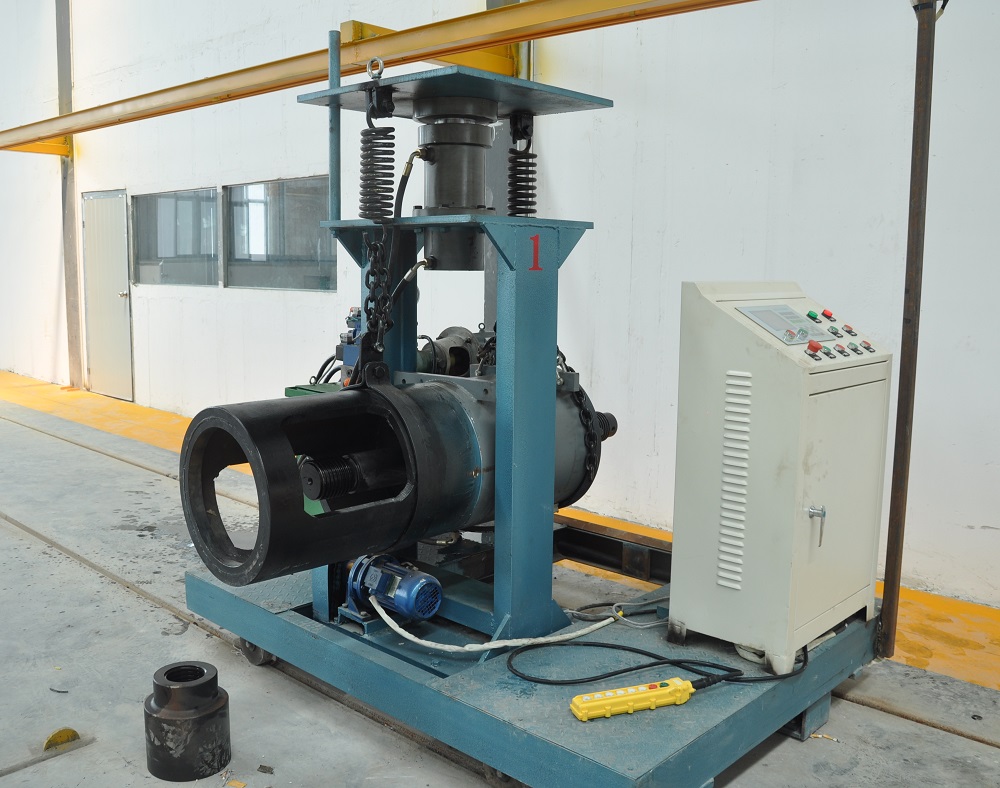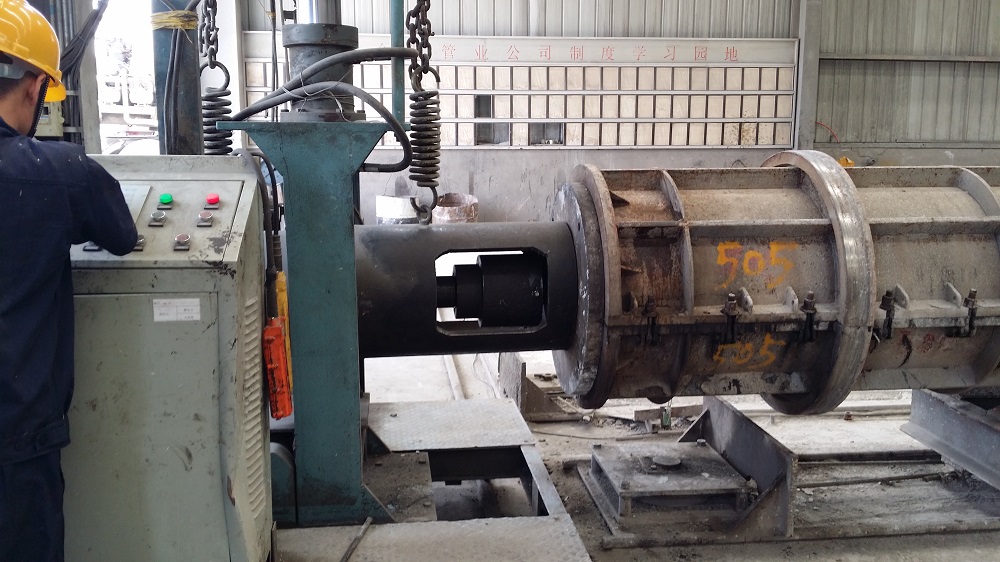Turbomolecular pump pumping system of the basic method of operation: A turbopump extraction system with a separate roughing line operates in a similar manner to a diffusion pump extraction system. Before starting rough pumping, the high vacuum valve and roughing valve are closed while the foreline valve is open. 1, first close the front-stage valve, start roughing pump (also the former stage pump), open roughing valve to start vacuuming the vacuum chamber. The pressure in the vacuum chamber down to 150 ~ 100Pa closed roughing valve, open the foreline valve, 2, and then start the turbo molecular pump (to be connected to the cooling system). If the inlet of the molecular pump is filled with liquid nitrogen cold trap, liquid nitrogen should be filled after the pump is accelerated to rated speed (usually 5 ~ 10min). Rough pumping system configuration varies with the size of the vacuum chamber. For 500L / s or smaller turbo molecular pump, a two-stage rotary vane pump can be used; while the turbopumps with a capacity of 1000L / s and more adopt the mechanical pump as the primary pump's Roots pump unit. Close the roughing valve at a pressure of 100 to 150 Pa and switch the vacuum chamber to the turbomolecular pump. For some pumps, doing so causes a slight, but slow, instantaneous deceleration, but this has no effect on pumping. Just as the diffusion pump extraction system, the most important substance in the turbomolecular pump system is water vapor, and its pumping time will be governed by the liquid nitrogen trap pumping speed. Without a liquid nitrogen cold trap, the system will pump water slightly slower than a cold-trap diffusion pump of the same pumping speed. At the very beginning of a high-vacuum pumping process, the pump's large, unbaked interior surface will adsorb water and then be released again at a lower pressure. This effect is more pronounced in valveless systems because it may adsorb more water vapor than a valved system that is not exposed to air at pressures higher than 150 Pa. 3, the system downtime, first close the high vacuum valve, if there is liquid nitrogen cold trap, but also the cold trap heating. After the cold trap reaches the equilibrium temperature, turn off the foreline valve, and then cut off the power supply of the turbopump motor to decelerate the molecular pump rotor. In general, it takes ten minutes or more until the pump rotor stops completely. During the deceleration of the molecular pump rotor, the hydrocarbon vapors from the foreline hydrocarbons and turbomolecular pumps rapidly diffuse to the area above the pump inlet. To prevent backflow of the mechanical pump vapor and turbo molecular pump lubricant vapors, the molecular pump is deflated with a dry reverse flow of air after the power to the turbo pump motor has been switched off. For example, when the pump rotor speed drops to about 50% of the maximum speed, argon or nitrogen should be continuously charged somewhere above the pump inlet or above the rotor assembly until the pressure in the pump reaches atmospheric pressure. This can be done properly by filling the valve 3 (see Figure 1) with gas. Turbomolecular pumps should not be filled with air at atmospheric pressure often when operating at rated speed. This is detrimental to the life of the shaft. After the current level pipeline valve is closed, the mechanical pump system can be switched off, and the deflation valve can be used to deflate the mechanical pump. Turn off the cooling water immediately after shutdown to prevent internal condensation. In normal operation, the water temperature can be adjusted slightly above the dew point to eliminate possible condensate outside the pump body. Start the system to connect the cooling water flow, open the foreline valve, and then start the mechanical pump and turbo molecular pump. After the pump is accelerated to the rated speed (typically 5 to 10 minutes), the liquid nitrogen cold trap can be filled. The vacuum chamber can then be evacuated as described in the previous section. 4, the following one is given is not the use of high-vacuum valve pumping system operation than the valve pumping system is much easier. Operation: First open the cooling water and the foreline valve, and at the same time start the mechanical pump and turbo molecular pump. If the roughing pump is properly chosen so that the roughing time of the vacuum chamber is equal to the acceleration time, the vacuum system can pump the vacuum chamber to its background pressure without the return of the pump oil vapor. 5, valveless system deflated and shut down: 1) First close the foreline valve, and wait for the pump speed to drop to 50% of the maximum speed before charging dry gas above the pump. When the system is filled to atmospheric pressure should close the deflation valve, otherwise it will cause the vacuum chamber over-pressure. 2) Then switch off the mechanical pump and stop the cooling water as described above. There is no turbo molecular pump system with a single roughing line: first turn on the molecular pump cooling system and foreline valves, and at the same time start the pre-stage (roughing) mechanical and turbo-molecular pumps. If the roughing pump (forepump) is properly selected so that the roughing time of the vacuum chamber equals the acceleration (start up) time of the molecular pump, the vacuum system can pump the vacuum chamber to it without the return flow of pump oil Background pressure. 3) Before shutting down the system, it is necessary to close the foreline valve, then cut off the power of the molecular pump and turn off the cooling water. When the molecular pump speed drops to half of the rated working speed, dry gas is filled in the pump inlet. When the system is filled to atmospheric pressure, the deflation valve should be closed. Shut off the forepump system at any time after the foreline valve is closed as needed. More Search Keywords: Pumps
Concrete Pile Pre-stressed/Tension Machine:
Tension Machine is a kind of feedthrough pre-tensioing. It is also called spun pile tension jack machine, pole tension machine, prestressed tension machine etc. It is the neccesary equipment to produce Pre-stressed concrete spun pile and prestressed concrete pole products. As the end of the tension rod is connected to the anchor with thread, it can be applied to various forged anchors, chilled iron anchor used for stayed-cable bridge and other similar anchors, as well as pre-tension pulling for pipes. In accordance with actual requirement.
HH Tension Machine's advantages:
1. The large-screen LCD display.
2. Double control mechanism of touch screen and keyboard, high reliability.
3. Directly work after the input of tensioning data, and the oil cylinder will automatically complete the tensioning process to reduce uncertain factor of manual operations and improve the tensile quality.
4. Built-in SD card function, which can save the tensile data to the computer regularly, and check the record at any time.
5. With its own printer, it can print tensile data in working time, avoiding the tedious and unstable manual record and ensuring the traceability of tensegrity data is verified.
Technical Parameter:
1. Oil pump flow: 12L/min
2. Motor power: 7.5kw
3. Rated power: 31.5Kpa
4.Tension force: 2000KN
5. Tension stroke: 200mm
6. Programmable controller of automatic control system + input and output of analog data Color touch screen, USB interface output
7. Control voltage: 380V+24V
8. Accuracy of prestress control:±0.1Mpa
9. Data transmission rate is 100%
Main configuration:
Automatic tension control system, 300T jack, oil pump, lifting trolley, tensioning rod, tensioning head and supporting foot
If you have any questions, please contact with us. Welcome you can visit our Factory.For inqury,Please send mail directly to us.
Concrete Machine,Pre-Stressed Machine,Pre-Stressed Concrete Machine,Concrete Pre-Stressed Machine Jiangsu Haiheng Building-Materials Machinery Co.,Ltd , https://www.jshaiheng.com
